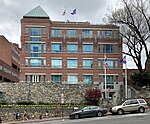Georgetown Waterfront Park
2011 establishments in Washington, D.C.Georgetown (Washington, D.C.)National Park Service areas in Washington, D.C.Parks in Washington, D.C.Protected areas established in 2011 ... and 1 more
Rock Creek Park

Georgetown Waterfront Park is a national park completed in Washington, D.C. in the fall of 2011. Part of the Georgetown Historic District, the park stretches along the banks of the Potomac River from 31st Street, NW to the Key Bridge. The result of many years of advocacy and fundraising, the site features several notable design elements. Now complete, the park links 225 miles (362 km) of parkland along the Potomac River stretching from Cumberland, Maryland to Mount Vernon, Virginia. The park was designed to passively complement the natural curve of the river.
Excerpt from the Wikipedia article Georgetown Waterfront Park (License: CC BY-SA 3.0, Authors, Images).Georgetown Waterfront Park
Capital Crescent Trail, Washington Georgetown
Geographical coordinates (GPS) Address Nearby Places Show on map
Geographical coordinates (GPS)
| Latitude | Longitude |
|---|---|
| N 38.902155 ° | E -77.061893 ° |
Address
Capital Crescent Trail
20566 Washington, Georgetown
District of Columbia, United States
Open on Google Maps






